How to properly sow cabbage for seedlings at home
Cabbage is not the last place in the summer cottage of every gardener. This is due to the fact that the vegetable is not only suitable for preparing vitamin salads, but also used in many other dishes.
Since you have decided to grow cabbage through seedlings, then you need to familiarize yourself with some rules and recommendations for planting, caring for and growing cabbage seedlings at home.
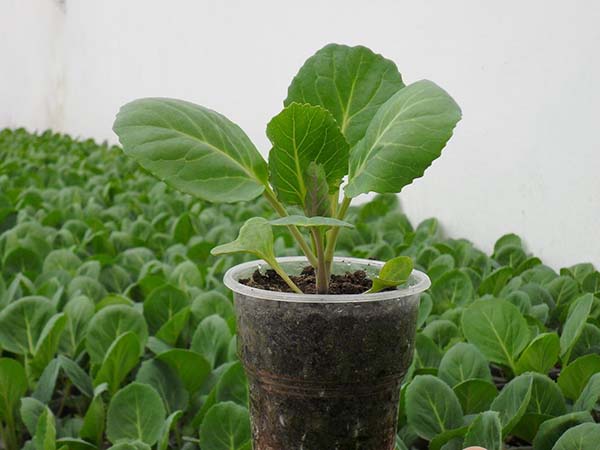
Content
How to properly plant cabbage for seedlings at home
In order for the seedlings to be strong and healthy, it is necessary to properly sow, and first properly prepare the seeds, containers and soil, and of course it is very important to choose the optimal timing. Only strict adherence to the recommendations will help to avoid serious mistakes that can negatively affect the growth and development of cabbage seedlings in the future.
When to Sow Seeds: Optimal Sowing Times
Note! The site already has a detailed article about how to correctly calculate the timing of sowing cabbage for seedlings, including indicated favorable days for planting in 2020 according to the lunar calendar.
Seed preparation for sowing
Before planting cabbage seeds, it is necessary to pre-sow them. This procedure is intended for both self-collected and purchased seed. For this, it is required to initially carry out a visual selection, screening out all damaged specimens, as well as those that are significantly larger or smaller than the bulk. 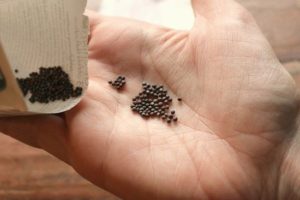
Then it is recommended to carry out processing (pickling) cabbage seeds from pathogens that can persist on the outer shell. To do this, they must first be soaked in warm water with the addition of potassium permanganate at a temperature of 40-50 degrees for 20-30 minutes.
You can spend disinfectionusing the drug "Fitosporin" (according to instructions).
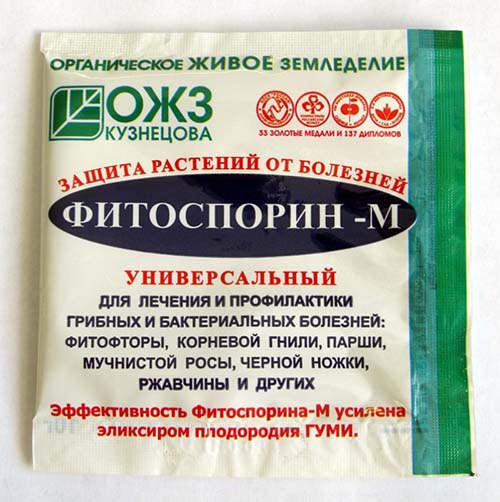
For stimulation of growth processes and increasing the percentage of germination it is recommended to soak with solution"Epina" (according to the instructions) or "Zircon" (according to the instructions). After that, the seeds must be immediately planted in the ground.

Better yet germinate cabbage seeds on cotton pads. In 2-4 days, the seeds will hatch, and they can be planted in the ground.
Important! If, when buying cabbage seeds, they are painted in different colors (it is more correct to call them coated, granulated or glazed), then this indicates that the manufacturer has already worried about them in advance and has carried out a full pre-sowing preparation. Therefore, no action is required with them. Planting should be done dry.
Video: soaking cabbage seeds
What soil to plant
Important! For planting, you cannot take soil from the area where cruciferous crops (rutabagas, turnips, radishes, horseradish) grew, since they have common diseases.
Sowing cabbage seeds must be carried out in a light and nutritious substrate, which will enable the plants to fully develop. The best option would be to buy ready-made soil for cabbage seedlings, where the composition of the soil is completely balanced and has a neutral acidity level within 6.5-7 pH.
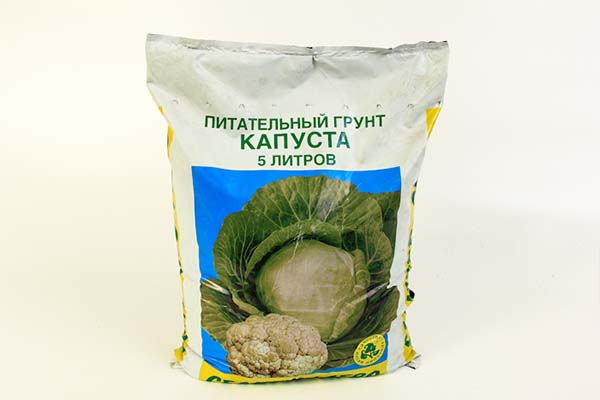
You can also prepare the necessary soil for planting cabbage yourself by mixing the following components:
- sod land - 1 part;
- sand - 1 part;
- 1 glass wood ash for 10 liters of soil.
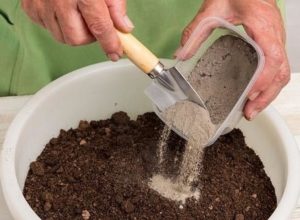
Important!You should not apply nitrogen fertilizers and humus to the soil, as this can lead to excessive growth of the aboveground part and further lodging of seedlings.
In addition, it is recommended to disinfect the substrate from pathogens of fungal diseases before planting cabbage. To do this, a few days before sowing, it is necessary to shed the soil with the working solution of the drug. Fitosporin (according to the instructions) or a rich pink infusion of potassium permanganate.
And then it is advisable to sift the substrate and loosen it thoroughly in order to increase its air and moisture permeability.
Planting containers
For planting cabbage for seedlings, you can use wooden or plastic boxes and pallets, but there are also other containers that you should pay attention to. To understand their advantages and disadvantages, you should familiarize yourself with them in advance.
Important! The most important thing is that there are drainage holes at the bottom of the landing container.
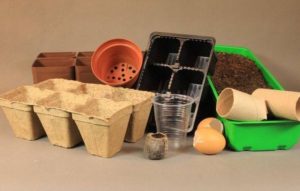
- Containers made of wood or plastic. This type of container has been used for planting seeds for a very long time due to its ease of use.Wooden structures can be completely built independently, at no extra cost. They are suitable both for sowing and for picking seedlings in the future. The disadvantage of containers is that the root system can be damaged during transplantation. It is also impossible to get one plant without affecting the neighboring one. In addition, these structures are quite heavy.
- Plastic cups. They are also very popular with gardeners due to their low cost and reusable use. In addition, sowing in such containers allows the extraction of plants without damaging the root, which reduces transplanting stress. But this type of container has several disadvantages. The cups do not have drainage holes, so you should make them yourself, and you need to purchase additional trays to water the plants. In addition to all this, they do not have stability and need additional devices when transporting seedlings to their summer cottage.
100-200 ml cups will be enough.
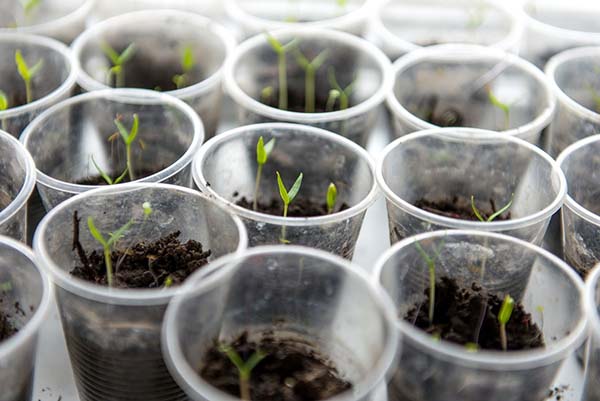
- Plastic cassettes. Not so long ago, the appearance of the landing tank. Often sold together with a pallet and a lid, which makes it easier for the gardener. Represents individual cells connected into a single whole, which allows you to plant the plants separately at once. They have drainage holes and can be easily cut with scissors if necessary. The root system is not damaged during transplantation. The disadvantage is that they break easily and are inconvenient for further transportation of seedlings.
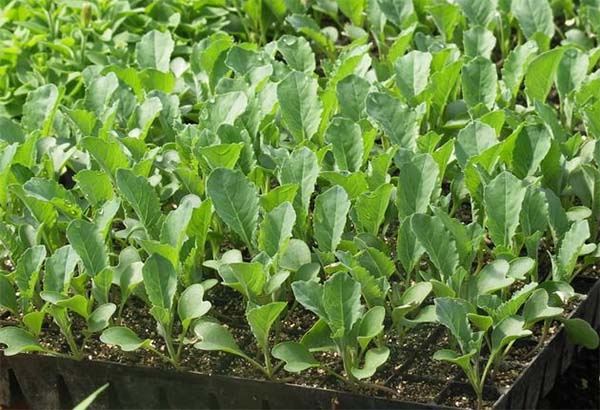
- Peat tablets. The best option for growing seedlings, allowing you to grow strong seedlings with a well-developed root system. For planting, you need to wet the tablets for 7 minutes in water until they swell completely. They are nutritious compressed peat, placed in a special shell, which completely dissolves when planted in the ground. This allows planting into the ground without damaging the root. The disadvantage is the high price and the need for frequent watering, since moisture from the substrate quickly evaporates. Additional equipment will be required for transportation.
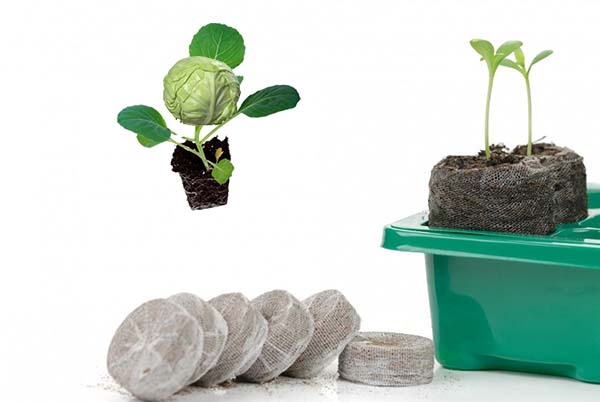
By the way! Cabbage can be sown for seedlings and in banks, for more details on this method, see the following video:
Sowing scheme
Planting should be carried out taking into account the fact that plants will need free space in the future for full development. Therefore, crops should not be overly thickened.
Advice! It makes sense to sow thicker only in order to then leave the strongest shoots. Moreover, they do not need to be pulled out, but cut off with scissors.
If you are going to dive, then you need to place seeds in a common container at a distance of 1.5-2 cm from each other and with a row spacing of 3-4 cm.
And if you plant seeds in a common container at a distance of 5-10 cm in a checkerboard pattern, then seedlings can be grown without picking.
Of course, it is ideal to sow immediately in separate containers, so as not to carry out a pick in the future, because cabbage does not really like it, especially cauliflower.
Important! The thickening of crops is the cause of weak and elongated cabbage seedlings, and can also cause the development of various diseases.
Video: preparing seeds and sowing cabbage for seedlings
Direct landing
When planting cabbage seeds for seedlings, you must consistently perform the steps. This will help prevent serious blunders that can negatively affect the plants in the future.
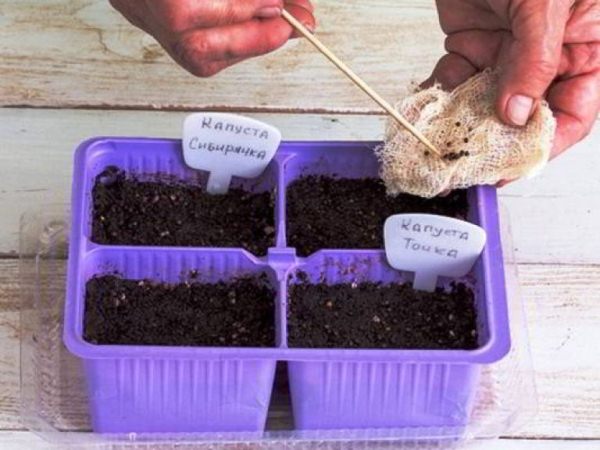
Step-by-step instructions for sowing cabbage seeds for seedlings:
- Pour the prepared substrate into the planting containers (2/3).
- Water it abundantly and wait until the water is completely absorbed and the soil settles.
- Make rows 1 cm deep and spread out the seeds.
- Sprinkle earth on top.
- Moisten the substrate from above with a spray bottle.
- Cover with a transparent lid or foil to keep high humidity inside.
- Put containers on the window and ensure the temperature of the content is up to + 18 ... + 22 degrees (less for white cabbage, more for color).
Video: a proven method of sowing cabbage for seedlings (white cabbage)
Note! There are no major differences in sowing and growing different types of cabbage, but there are some small nuances, especially for cauliflower (it is more thermophilic).
You might find it helpful to watch the following videos:
Video: especially growing and sowing Peking cabbage for seedlings
Video: sowing and growing cauliflower seedlings - the subtleties of the process
Further care and growing cabbage seedlings at home
To grow healthy and robust cabbage seedlings at home, you need to create optimal conditions.
Temperature regime
Remember! Cabbage is a cold-resistant plant. The only exception is cauliflower: it needs more room conditions, but it does not tolerate too high temperatures.
As soon as the cabbage seedlings hatch and friendly shoots appear, the temperature of the content must be set in this range (recommended for white cabbage and other types of cabbage, except cauliflower): in the daytime - + 14-18 degrees, and at night - + 8-12 degrees. Such a regime will help curb the excessive growth of the aboveground part (prevent it from stretching) and will allow the root system to grow.
Therefore, it is advisable to take out containers with seedlings to a balcony or loggia. Or, if you only have a window sill, then slightly open the windows, setting them to the winter ventilation mode.
In general, as a rule, trays with cabbage seedlings are placed in a greenhouse.
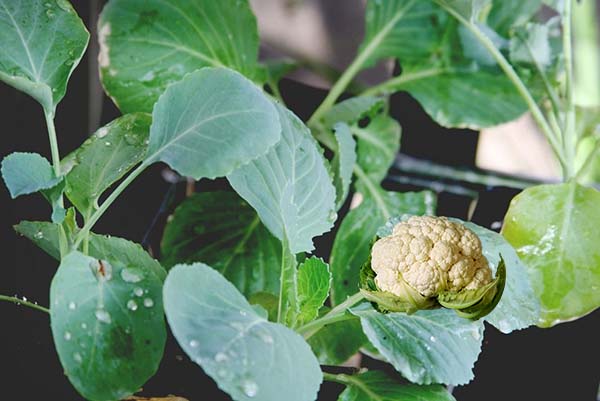
But the seedlings cauliflower It does not tolerate low temperatures well, therefore, for its successful cultivation, the temperature both in the daytime and at night must be 4-6 degrees higher, i.e. during the day - + 18-22 degrees, at night - + 14-18 degrees.
Interesting! Cauliflower does come in different colors, but it got its name not because of this, but because it is the flowers (tightly pressed buds) of this plant that we eat, and not the leaves.
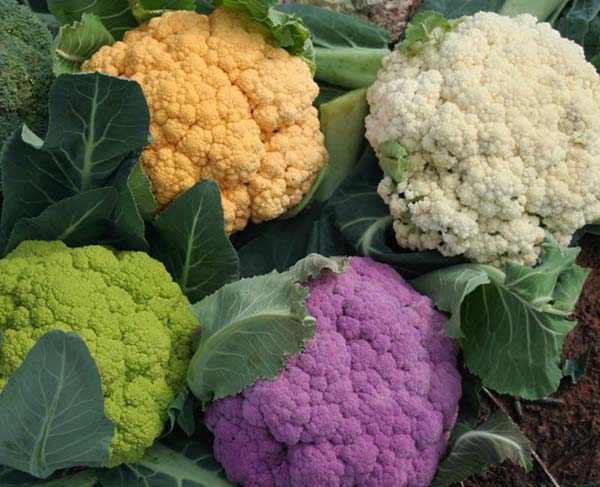
Lighting
Cabbage is a light-loving crop, so any slight darkening can lead to the death of seedlings. For the full growth of cabbage seedlings, daylight hours should be within 12-15 hours.
Planting containers with seedlings should be placed on the southern windowsill, or at least on the southwest or southeast. And in the evening or morning hours, if possible, provide backlight phytolamps.
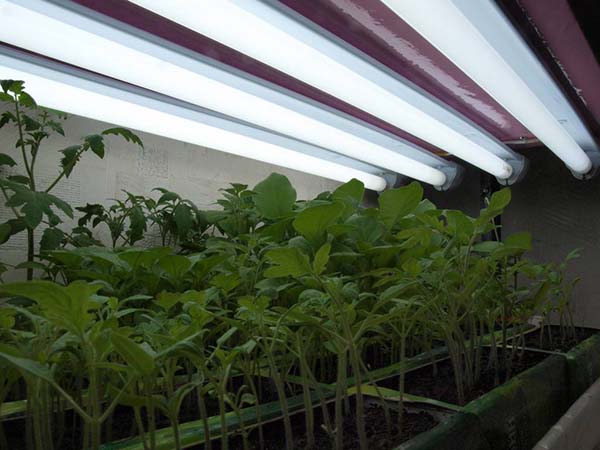
Watering and moisture
Watering the cabbage planted on seedlings should be carried out as the topsoil dries up, avoiding overflow and drying out of the roots. In this case, water should not fall on the leaves.
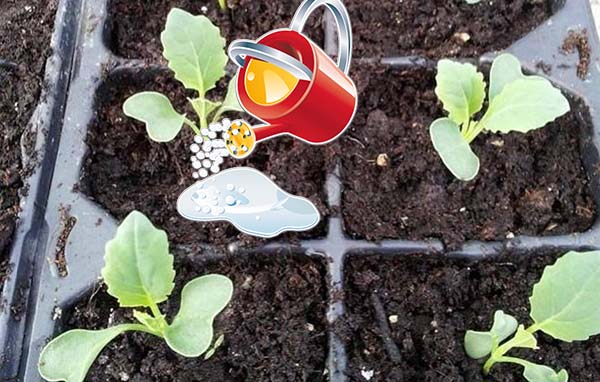
Note! It is strictly forbidden to water cabbage seedlings with cold water, only warm or at least room temperature. The optimal water for irrigation is rain or melt water. Ordinary running water, passed through a filter and settled for 24-48 hours at home at room temperature, is also suitable for watering cabbage.
Top dressing
Fertilizers must be used to keep cabbage seedlings strong and healthy. This will help her to develop more actively and fully.
However, if you initially prepared nutrient soil (with humus or compost, wood ash), then, in principle, no additional feeding is required. Of course, if the appearance of the plants does not require the opposite.
Cabbage seedlings are fed in the following order:
- at the stage of appearance of 2 cotyledonous leaves (7-10 days after germination);
- 10-14 days after the first (in the phase of 2 true leaves);
- 10-14 days before disembarkation in open ground.
By the way! If you are growing with a pick, then the first feeding should be done 7-14 days after it.
First feeding You can do yeast infusion... Dissolve 10 grams of dry yeast in 1 liter of water, add 3-4 tbsp.tablespoons of sugar, let it brew for 4-6 hours and pour under the root.
The second dressing should contain a lot of nitrogen. For example, you can sprinkle with herbal infusion (for example, from nettle) or use mineral fertilizers (for example, ammonium nitrate or urea).
You also do not want to bother, then for feeding cabbage seedlings it is recommended to use complex mineral fertilizers containing nitrogen, phosphorus and potassium in equal proportions. For example, nitroammofosku (all 16%). Or prepare such a top dressing from different fertilizers, for example, taking 2-3 g for 1 liter urea, 3-4 g superphosphate and 2-3 g of potassium sulfate.
Video: how to care for cabbage shoots
Pickling cabbage seedlings
By the way! The site already has a detailed article aboutpicking cabbage seedlings.
The picking procedure involves planting plants in separate and more spacious containers.
A picking of cabbage seedlings is needed only if the sowing of seeds was carried out in one common container and the seedlings did not have enough space. In general, cabbage is not very fond of picking, because the procedure causes severe stress on the plant root system.
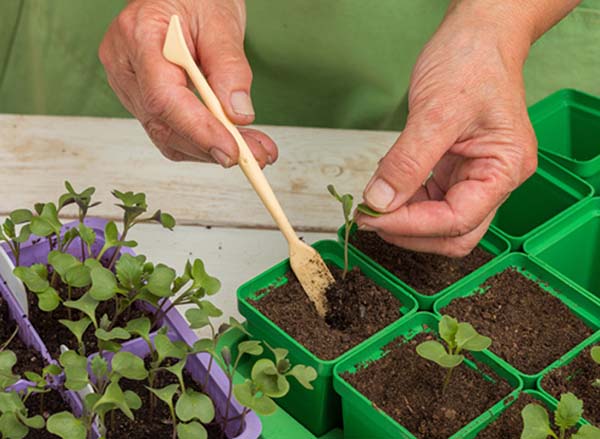
When how to pick cabbage?
The main condition is the appearance of 2 true leaves in the seedlings.
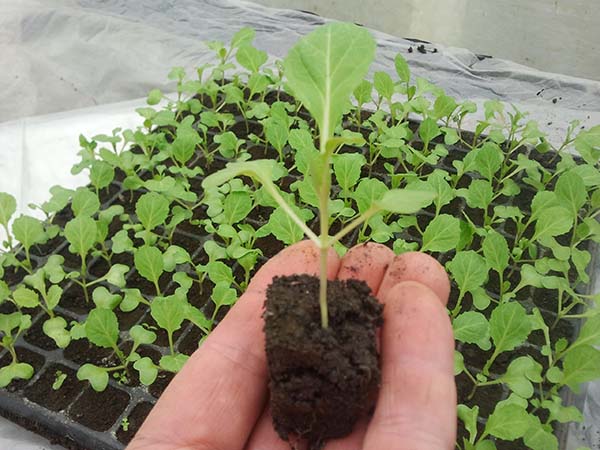
When picking, cabbage seedlings should be buried to the first pair of cotyledon leaves in order to form a strong root system.
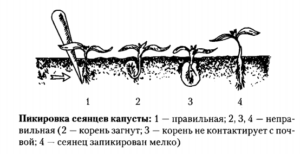
Immediately after the pick, for a couple of days, it is recommended to transfer the seedlings to a warmer room with an air temperature of +18 .. + 22 degrees. This will make it easier for the seedlings to get used to (more precisely, to get better) and to take root in new conditions.
By the way! On the website you can find a separate detailed article aboutpicking cabbage seedlings.
Video: how to dive cabbage seedlings
About picking cabbage when growing seedlings in the greenhouse see the following video:
Problems when growing cabbage seedlings
Sometimes the most harmless mistakes in caring for seedlings lead to the appearance of diseases: overflow, lack of lighting, increased temperature of the content. The most common problems when growing cabbage are:
- Cabbage seedlings turn yellow. There may be several reasons. So, the leaves may turn yellow due to a lack of elements in the soil such as phosphorus (then the leaves turn yellow on the underside and may acquire a red-purple tint), potassium (the tips of the leaves turn yellow), iron (turn yellow throughout the base). Yellowness can also appear from excessive nutrition - an overdose of fertilizers. To remedy such situations, the earth should be shed with water or completely transplanted into new soil.
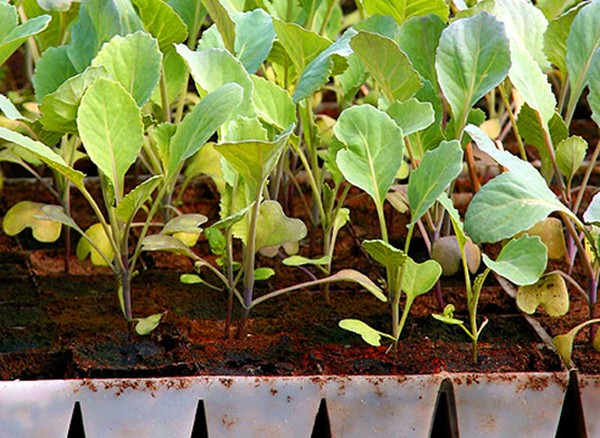
- Have cabbage seedlings curly leaves... As a rule, this occurs due to the bright sun on the window and from waterlogging of the soil, combined with dry air in the room. With good humidity and moderate temperatures, the curliness should pass. You can additionally feed with humic fertilizers, for example, Potassium humate, Humate +7, etc.
- Cabbage seedlings are rotting. As a rule, rotting is caused due to the appearance in seedlingsblack leg... In the affected seedling, the lower part of the stem first darkens and decays, then a constriction forms at this place, the plant dies and lies down. To prevent such an outcome, it is imperative to first disinfect the soil. If this was not done or the disease still appeared, then it is worth removing all infected seedlings, and spilling the earth with a solution of potassium permanganate (3-4 g per 10 l of water), after which do not water the seedlings for a week.
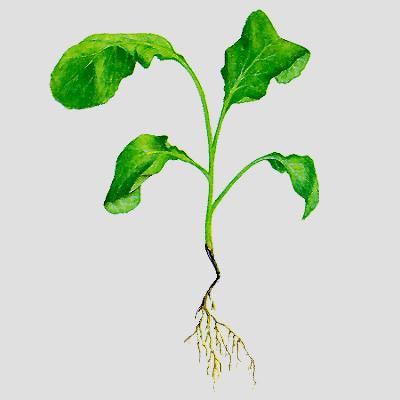
- Cabbage seedlings are pulled out. The main reasons are insufficient daylight hours and incorrect temperature conditions. But the seedlings can stretch out even in good lighting, if the planting density is too high, which is why not all plants have enough light. Naturally, without the recommended temperature regime, the normal development of seedlings should not be expected.
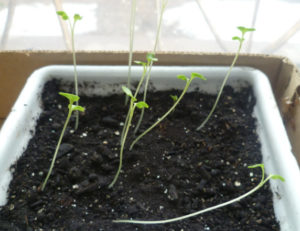
- Other diseases.Besides black leg, seedlings can hitphomosis (dry rot), keel and many others other very dangerous and destructive diseases.
To prevent the occurrence of the listed problems and seedling diseases, it is enough to follow all the recommendations for treating seeds and soil before planting, as well as to properly care for the plantings.
Video: prevention and treatment of cabbage seedling diseases
Dates of planting cabbage seedlings in open ground
Advice! The site already has a separate article volume when and how to plant cabbage seedlings in open ground.
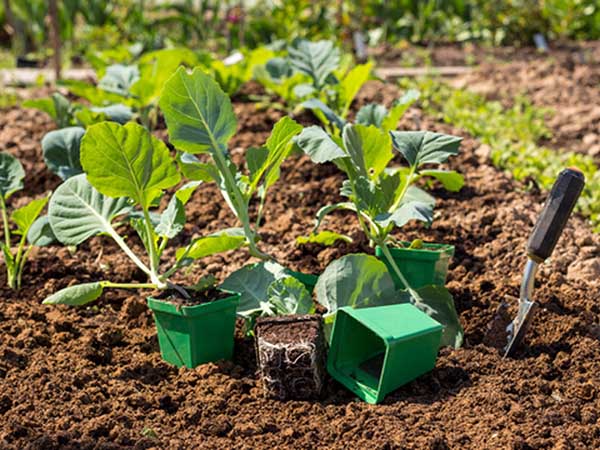
Thus, knowing all the rules and recommendations, planting cabbage seeds for seedlings and growing strong healthy seedlings at home will not be difficult even for a novice summer resident.
Video: the secrets of growing strong cabbage seedlings

